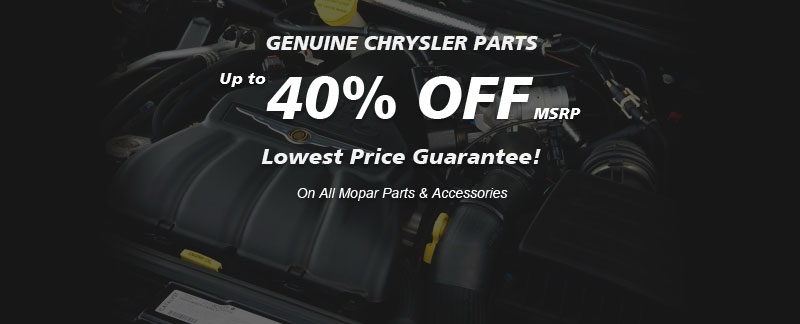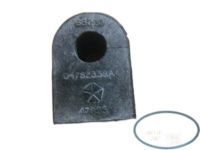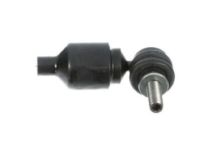Why choose MoparPartsGiant
- Fast Delivery
Your Chrysler Cirrus deserves only Chrysler Cirrus genuine parts from MoparPartsGiant.com. There's zero risk involved when buying from us because all our Chrysler Cirrus auto parts are expedited directly from authorized dealers and backed by the manufacturer's warranty. For years, we've been the #1 Chrysler Cirrus online parts store. Interested in faster shipping? We offer expedited shipping on corresponding orders!
- Dedicated Service
Our outstanding customer service team is here to help you by email, live chat, or phone call with any inquiries regarding your purchase. Dedicated representatives are standing by to assist you with your shopping needs. With a complete Chrysler Cirrus parts catalog and a full selection of inventory, your parts are ready to be expedited anywhere in the nation without delays.
- Unbeatable Prices
For any genuine Chrysler Cirrus parts you need for standard maintenance or repair, we carry them. With our unbelievably low prices on Chrysler Cirrus parts, you won't go anywhere else for Chrysler Cirrus parts. We are your one-stop shop for Chrysler Cirrus parts without breaking the bank!
Popular Genuine Chrysler Cirrus Parts
- Engine Parts View More >
- Electrical Parts View More >
- Fuel Parts View More >
- Body - Sheet Metal Except Doors Parts View More >
- Cooling Parts View More >
- Steering Parts View More >
- Interior Trim Parts View More >
- Transmission Parts View More >
- Brakes Parts View More >
- Suspension & Drive Parts View More >
- Doors & Related Parts View More >
- Exhaust Parts View More >
Shop Genuine Chrysler Cirrus Parts with MoparPartsGiant.com
The Chrysler Cirrus is a mid-sized sedan produced and marketed by Chrysler. First introduced in the 1995 model year, this model was the successor to the Chrysler LeBaron, competing effectively with smaller vehicles from other brands. Created by Michael Santoro in 1991 and built on the Chrysler JA platform, the Cirrus is a 4-door notchback sedan designed to blend affordability, style, enjoyable driving experience, and safety, making it ideal for everyday family use. It shares numerous similarities with the Dodge Stratus and Plymouth Breeze, which were built on the same platform, leading to these models often being perceived as similar vehicles. Initially, the Chrysler Cirrus was offered in two trim levels - a well-equipped base LX and the more luxurious LXi. Both models featured similar body side moldings, chrome bumper accents, a low extending chrome or body-colored waterfall grille, fog lights, sporty black twin-post side mirrors, an automatic transmission, and a 2.4L I4 engine. The LXi, an upgrade from the LX, added alloy wheels, keyless entry, chrome accents, wood grain interior trim, and a premium front grille. The production of the LX model ceased briefly in 1998 and was resumed in 2000 to fill the void left by the discontinuation of the Plymouth Breeze. However, it was ultimately discontinued in 2001 to make way for the Dodge Stratus. Renowned for offering more for its price in its class, the latest version of the Chrysler Cirrus is equipped with a 2.5L V6 engine.
The Chrysler Cirrus has encountered various problems across different models. One recurring issue, particularly in models from 1998 to 2000, is car stalling due to a lack of ignition spark. In the 1999 model, after reaching about 130,000 miles with an automatic transmission, the engine would halt and, in some cases, restart after a week. However, subsequent restarts would often fail. Remedies such as changing spark plugs and their accompanying wires were tried; though some necessitated the removal of the air inlet for access. Despite a functioning timing belt, the ignition spark remained absent. Utilizing an OBDII code reader to pinpoint trouble codes was recommended. For instance, during engine cranking, checking the voltage at the dark green wire with an orange tracer was crucial, and if it lacked voltage, the ASD relay circuits required inspection. It's worth noting that while the relay might function, if the car's computer didn't receive the correct cam and crank signals, the relay might not be activated. Moreover, other models like the 1998 variant showed persistent spark issues even after changes to the crankshaft sensor, distributor cap, and rotor. Though the OBDII indicated both crank and cam sensors were synchronized, experts were hesitant to pinpoint the problem solely to the CPU. A thorough examination of the spark path from the CPU, through the sensors, to the distributor and coil was advised. Replacing the CPU was discouraged, as the issue often lay elsewhere, with possibilities ranging from factory alarms to aftermarket kill switches. Coil resistance tests were also essential in addressing weak spark issues. Meanwhile, the 1999 Chrysler Cirrus model sometimes faced the engine shutting off while in operation. The problem wasn't typically due to the fuel pump or its filter, but more commonly to the crankshaft position sensor found at the transmission bell housing's rear. A malfunctioning sensor, often due to heat, would be misinterpreted by the engine computer as the engine stopping, prompting the deactivation of the Automatic Shutdown (ASD) relay, affecting the injectors, coil(s), and fuel pump. The key takeaway here was the necessity of inspecting the crankshaft position sensor when addressing unexpected engine shutdowns. Concurrently, the 1997 Chrysler Cirrus, armed with a 3-speed overdrive automatic transmission, reported intermittent failures in shifting to high (drive/overdrive) mode. This problem, which appeared suddenly without prior warning signs, activated the "check engine" light. Diagnostics highlighted faults in the transaxle control system and gear ratio errors, often attributed to faulty speed sensors or internal transmission issues. Experts primarily suggested inspecting the input and output speed sensors. While the output speed sensor's functionality was often evidenced by a working speedometer, the input speed sensor still required checks. Using an ohmmeter to measure resistance between 650 to 800 ohms on this sensor was recommended. If both sensors were functioning and the transmission fluid was at the correct level, the problem might be internal, demanding further hydraulic pressure tests for accurate diagnosis.
You have nothing to worry about if you choose OEM parts as they are the best you can get in terms of quality and longevity. This is because they are precisely-engineered with the meticulous specifications of the official factory. They have passed strict quality control tests during manufacturing, so you know they're durable and sure to fit. Welcome to your ultimate destination for affordable OEM Chrysler Cirrus parts, like Wiper & Washers And Cylinder & Keys, Air Conditioning & Heater. Here at our website, we not only provide genuine Chrysler Cirrus parts at unbeatable prices, but also guarantee their quality with the manufacturer's warranty. Coupled with our dedicated customer service and swift delivery, we're confident you won't find a better deal anywhere else.
Chrysler Cirrus Parts Questions & Answers
- Q: How to Remove and Inspect the front Stabilizer Bar and Stabilizer Bar bushing?A: First of all, before you remove the sway bar kit, Inspect the components for any cracks, tears, or distortion and replace any damaged components. Install the clamps and bolts, and align the link assemblies with the control arms. Install the wheels and lower the vehicle, tightening the lug nuts.
- Q: How Can I Check for Worn Balljoints?A: With the vehicle on the ground, check for any play in the ball joint grease fitting. Raise the vehicle and support it securely on jack stands, then check for any play in the ball joints by rocking the tire at the top and bottom. If there is any movement, the entire control arm must be replaced. The ball joint seal can be replaced by prying off the old seal and pressing a new one into place.



















































